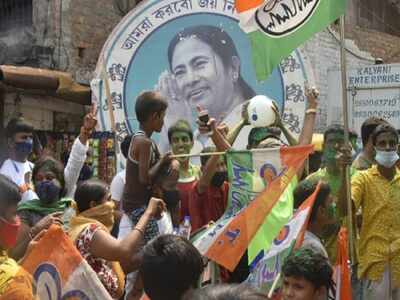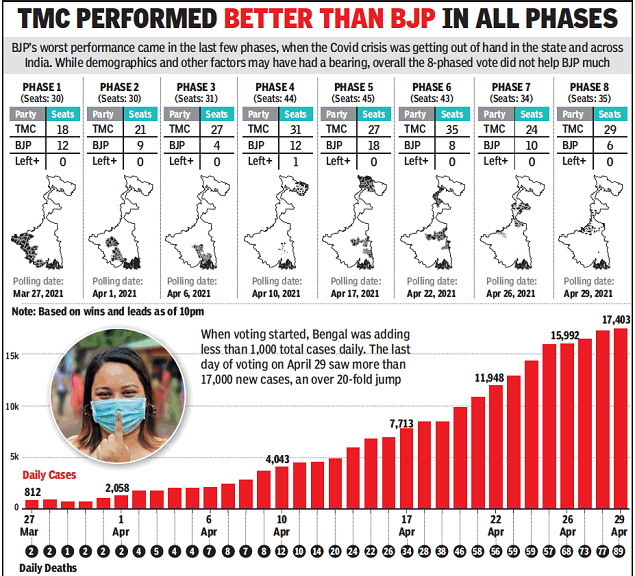Top Searches
- News
- India News
- Why Bengal swung Mamata’s way again

In the popularity contest, Mamata Banerjee as the daughter of West Bengal has won and Narendra Modi as BJP’s charismatic icon has lost in the just concluded elections. The third term mandate and a two-thirds majority, despite losing by 1,956 votes in Nandigram in East Midnapore, is incontrovertible affirmation of the Trinamool as the party that best represents the ethos of the state and an equally emphatic rejection of the BJP’s politics of polarisation on the basis of religious identities.
The increase in Trinamool votes is as significant as the decline in BJP’s vote share. The victory is an endorsement of Mamata’s politics and her policies that have been described by critics as populist, by expanding the social safety which is very different from the limited cover offered by the schemes of the Modi regime, based on a calculus of exclusion.

BJP’s overweening confidence in its strategy of consolidating the Hindu majority vote by excluding the widely dispersed Muslim vote that affects election outcomes in about 80 seats was one reason why its ambition for the conquest of West Bengal bombed. Without a strong organisation and carefully nurtured base, a deficit of leaders and no chief ministerial face, BJP was hasty in its assessment that it could take on Trinamool and oust Mamata from power.
If BJP had studied the rise of Mamata and her party, it would have discovered that she did not succeed in defeating the entrenched CPM-led Left Front in her first attempt. She failed in 2001, even when pundits had predicted that she would win. Trinamool sank in 2004 when it won only two seats in the Lok Sabha. The party revived on the base it built after 2001 in rural West Bengal, culminating in the Nandigram and Singur land agitations and ultimately wresting from the Left its support among the rural population and urban poor.
In targeting Mamata personally, by advising her to wear Bermudas so that she could show her leg, and heckling her, BJP made the mistake of underestimating her appeal among women voters, especially young women voters. It misread what was the most valuable part of the culture of Bengal, which is its history of socially progressive reform, and instead focused on explaining to voters how it would defend orthodoxy against Mamata’s politics of Muslim appeasement.
As the principal opposition, BJP will doubtless pursue its agenda based on the narrative it constructed in 1989 when it launched its Ram Mandir movement that West Bengal’s Hindu population is in danger of being swamped by an expansion in the number of Muslims. The narrative has been developed to paint all other parties into entities that helped Muslims acquire papers as citizens. It has not worked in consolidating the Hindu vote, but it will remain on the political agenda in the state.
The increase in Trinamool votes is as significant as the decline in BJP’s vote share. The victory is an endorsement of Mamata’s politics and her policies that have been described by critics as populist, by expanding the social safety which is very different from the limited cover offered by the schemes of the Modi regime, based on a calculus of exclusion.

BJP’s overweening confidence in its strategy of consolidating the Hindu majority vote by excluding the widely dispersed Muslim vote that affects election outcomes in about 80 seats was one reason why its ambition for the conquest of West Bengal bombed. Without a strong organisation and carefully nurtured base, a deficit of leaders and no chief ministerial face, BJP was hasty in its assessment that it could take on Trinamool and oust Mamata from power.
If BJP had studied the rise of Mamata and her party, it would have discovered that she did not succeed in defeating the entrenched CPM-led Left Front in her first attempt. She failed in 2001, even when pundits had predicted that she would win. Trinamool sank in 2004 when it won only two seats in the Lok Sabha. The party revived on the base it built after 2001 in rural West Bengal, culminating in the Nandigram and Singur land agitations and ultimately wresting from the Left its support among the rural population and urban poor.
In targeting Mamata personally, by advising her to wear Bermudas so that she could show her leg, and heckling her, BJP made the mistake of underestimating her appeal among women voters, especially young women voters. It misread what was the most valuable part of the culture of Bengal, which is its history of socially progressive reform, and instead focused on explaining to voters how it would defend orthodoxy against Mamata’s politics of Muslim appeasement.
As the principal opposition, BJP will doubtless pursue its agenda based on the narrative it constructed in 1989 when it launched its Ram Mandir movement that West Bengal’s Hindu population is in danger of being swamped by an expansion in the number of Muslims. The narrative has been developed to paint all other parties into entities that helped Muslims acquire papers as citizens. It has not worked in consolidating the Hindu vote, but it will remain on the political agenda in the state.
FacebookTwitterLinkedinEMail
end of article
Trending Topics
Quick Links
Coronavirus in MumbaiFarm bill 2020Farmers protestCoronavirus in DelhiCoronavirus in BangaloreCoronavirus symptomsCoronavirus in IndiaWest Bengal elections 2021Coronavirus NewsSolar EclipseNPRWhat is NRCCAB BillCAB and NRCAssam election 2021Podcast newsLok SabhaTamil Nadu Election 2021CongressBJP newsKerala Elections 2021Indian ArmyISRO newsSupreme Court